A door knob sticking when turned can be caused by a faulty latch or latch plate alignment issues. Dealing with a sticking door knob can be quite frustrating.
It can happen anytime, anywhere, and can interfere with your day-to-day activities. A door knob is not only a necessary aspect of your home’s security system but also impacts your home’s aesthetic appearance. Therefore, it’s vital to address the issue as soon as possible.
The problem can occur due to several reasons, like lack of lubrication, a misaligned latch plate, a faulty lock mechanism, or a worn-out latch bolt. Usually, a simple fix can help resolve the issue, and you won’t need to buy a new door knob.
In this article, we will discuss the possible reasons why your door knob is sticking and how you can address each issue.
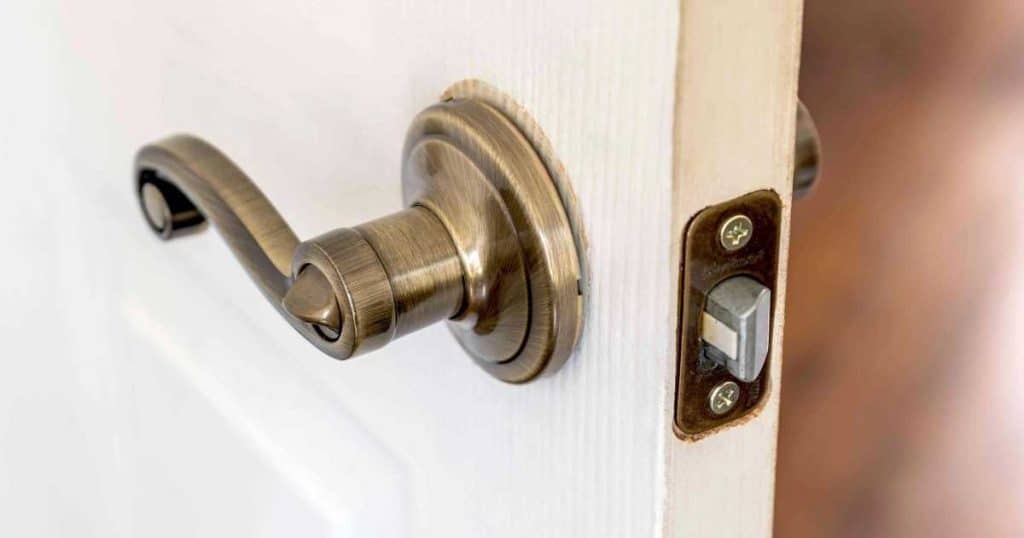
The Causes of Door Knob Sticking When Turned
The sticking of a door knob when turned can have various causes. One common reason is a buildup of dirt, dust, or debris within the locking mechanism.
Additionally, worn-out or improperly lubricated internal parts may contribute to the sticking.
Another factor could be misalignment of the door or the strike plate, hindering smooth operation. If the door itself is swollen or warped due to changes in humidity, it might impede the knob’s movement.
Here are some common reasons for a sticking door knob:
- A misaligned strike plate is one of the most common reasons why a door knob sticks. Adjusting the position of the strike plate can often fix the problem.
- A buildup of dirt, dust, or debris inside the door knob can cause it to become stiff and difficult to turn. A good cleaning may be all that is necessary.
- If the door knob is excessively worn or damaged, it may need to be replaced.
- If the door knob has insufficient lubrication, it may stick even after cleaning. Adding a lubricant may be necessary to make the door knob turn smoothly.
Regular maintenance, cleaning, and proper lubrication can often resolve these issues, ensuring your door knob turns smoothly.
How to Diagnose The Door Knob And Surrounding Area?
Checking the door knob and surrounding area thoroughly is the first step in diagnosing a sticking door knob. Here are some key points to keep in mind:
- It is essential to inspect both the door knob and the strike plate to determine the root cause of the problem.
- Check the strike plate for any visible damage, such as scratches, cracks, or bends.
- Verify that the screws on both the door knob and the strike plate are securely in place.
- Make sure that the latch assembly is aligned correctly and engages smoothly with the striker plate.
Why does my door knob stick when I turn it left?
If your door knob sticks when turned left, a likely culprit could be an issue with the internal components of the knob or latch mechanism. One possibility is the accumulation of debris or inadequate lubrication within the knob, hindering its smooth rotation.
Another factor might be wear and tear on the internal parts, causing friction and difficulty in turning the knob to the left.
To address this, consider disassembling the knob, cleaning any accumulated dirt, and applying a suitable lubricant to the moving parts.
If the problem persists, inspect the internal components for signs of damage or wear. Replacing worn-out parts or the entire knob assembly may be necessary to restore smooth functionality when turning it left.

Why is my door latch not springing back?
A door latch failing to spring back can be attributed to a few potential causes. One common reason is a misalignment between the latch and the strike plate, hindering the proper engagement of the latch.
Another possibility is the accumulation of dirt or debris within the latch mechanism, impeding its movement.
Additionally, a worn-out or damaged spring inside the latch assembly may cause the latch to fail to spring back.
Why is my door latch no longer catching?
If your door latch is no longer catching, several factors might be at play. One common issue is misalignment between the latch and the strike plate. If they’re not properly aligned, the latch won’t engage with the strike plate, preventing it from catching.
Another potential cause is wear and tear on the latch mechanism, which can lead to a diminished ability to secure the door. Additionally, the strike plate itself may be loose or improperly installed.
I’d recommend checking the alignment of the latch and strike plate, ensuring they are properly positioned. If the latch or the strike plate show signs of wear, replacement might be necessary.
Why is my door suddenly sticking?
A sudden sticking door can result from various factors. Changes in humidity or temperature can cause the door to swell or warp, leading to increased friction and difficulty in opening or closing. Additionally, settling of the building or shifting of the door frame may cause misalignment, impacting the smooth operation of the door.
To address this, consider checking for any visible signs of warping on the door or misalignment in the frame. Adjusting the hinges or, in some cases, planing the edges of the door may help alleviate the sticking issue.
It’s also advisable to examine the door for any loose or damaged hardware, as this can contribute to the sudden sticking.
Tools Required For Fixing The Problem
Once you have identified the cause of the problem, you may need some tools to fix it. Here are some tools that may come in handy:
- Screwdrivers
- Pliers
- Allen wrenches
- Cleaning supplies, such as a brush or cloth
- Lubricants, such as wd-40 or graphite powder
Remember to always follow proper safety precautions when making any repairs to your door or door knob. If you are not confident in your ability to fix the problem, consider calling a professional locksmith or handyman to assist you.
Easy Solutions That Work
Once you know the causes and can diagnose them properly, the next imperative task is to learn about the solutions and techniques. Let’s find some simple solutions that work for fixing door knobs that stick when turned.
Lubricating The Door Knob Mechanism:
When your door knob is sticking, it can be a frustrating experience, but a simple fix like lubricating the mechanism may do the trick. We have described the process of lubricating the door knob in the later part of this article for your assistance.
Adjusting The Strike Plate:
If lubricating the mechanism doesn’t solve the problem, adjusting the strike plate may also be a solution. The first step is to make sure that the strike plate is correctly aligned with the latch on the door. Check that the latch lines up with the opening in the plate.
If the alignment seems correct but the door still sticks, try loosening the screws that hold the plate in place. Adjust the plate by moving it slightly up or down, and tighten the screws back up.
Once the plate has been adjusted, test the door to ensure that it opens and closes smoothly. If it still sticks, repeat the process until the desired result is achieved.
Tightening Loose Screws And Hinges
Loose screws and hinges can cause a door knob to stick, so it’s important to make sure that they are secure.
Replacing The Door Knob Assembly:
If none of the above solutions work, replacing the door knob assembly may be necessary. To know how to replace, scroll to the below sections.
Remember to follow these easy solutions: lubricate, adjust, tighten, and, if necessary, replace your door knob assembly.
Step-By-Step Guide To Fixing A Sticking Door Knob
Doors are an essential part of our everyday lives, and it can be frustrating when they don’t operate correctly. One common problem is a sticking door knob. Fortunately, this issue is relatively easy to fix with a little knowledge and some simple tools.
In this guide, we’ll go over the step-by-step process for fixing a sticking door knob.
Method-1: Lubrication Process
The first step in fixing a sticking door knob is to lubricate it. This process involves applying a lubricant to the area where the knob meets the door and the latch mechanism.
Here’s how to do it:
Identify the right lubricant. An all-purpose lubricant or silicone-based lubricant can be effective for door knobs, but avoid using petroleum-based lubricants as they can cause damage to the mechanism over time.

Remove the doorknob. You will likely need to remove the doorknob to lubricate it thoroughly. This can typically be accomplished by loosening and removing screws, but consult the manufacturer’s instructions if you are unsure.
Apply the lubricant. Once the doorknob is removed, apply a small amount of lubricant into the hole of the knob. Also, spray a small amount of lubricant onto the latch mechanism. Be careful not to use too much, as excess lubricant can attract dust and debris over time.
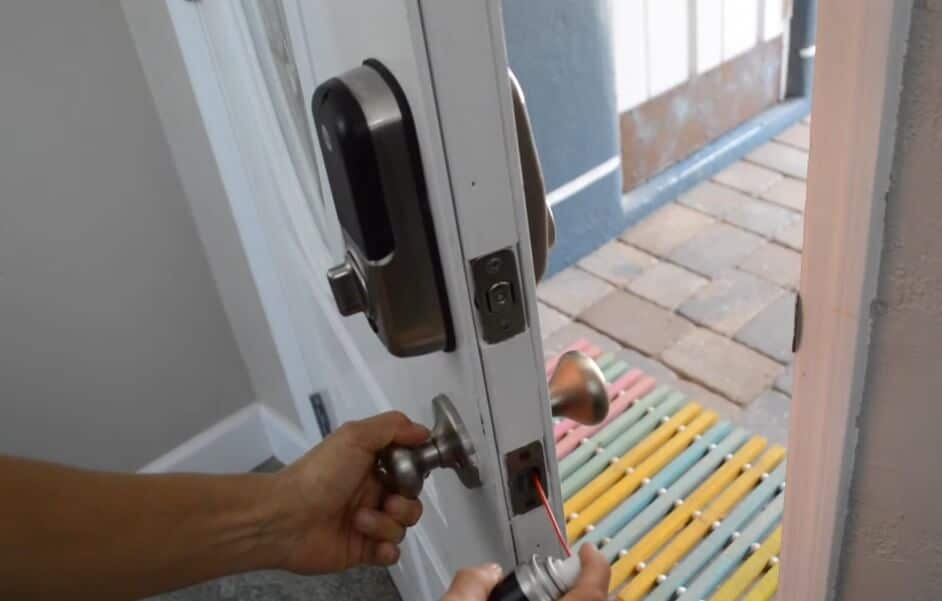
Reassemble the doorknob. Once the lubricant has been applied, reassemble the doorknob and test it to ensure it is working properly.
Method-2: Adjustment Process
If lubricating the knob does not fix the issue, you may need to adjust the door knob. Here’s how:
Remove the door knob as described in the previous section.
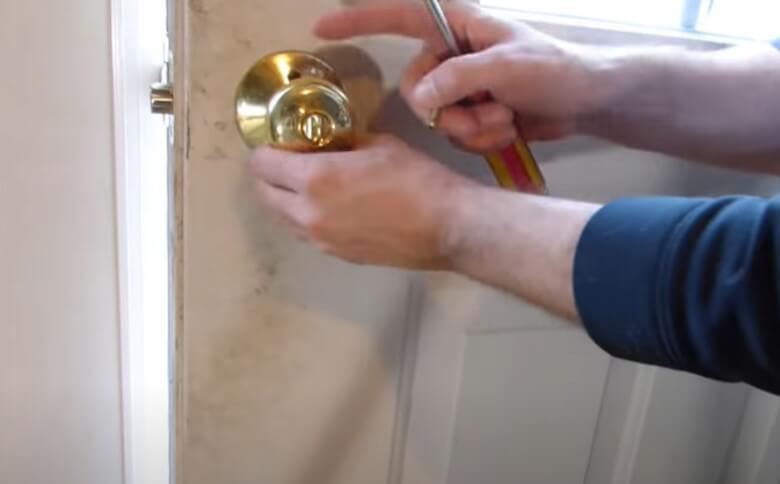
Look at the latch mechanism, and you will see two screws.
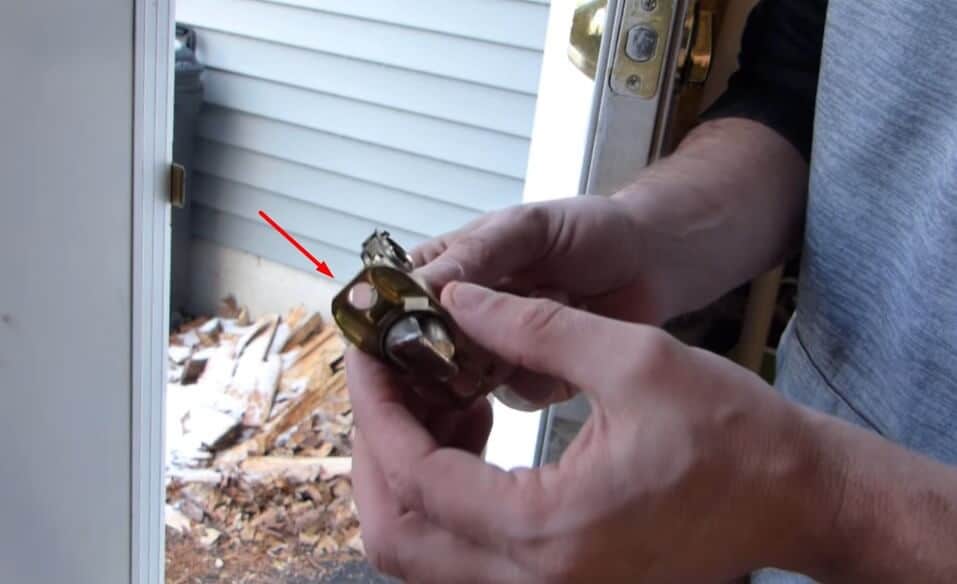
Loosen one of the screws, and then test the knob. If it doesn’t work, tighten the screw back up and loosen the other one instead.
Keep adjusting the screws until the knob turns correctly without sticking.
You can also apply some lubricant to make the latch mechanism easier.

Put the knob back in place and reattach the screws.
Method-3: Tightening Screws And Hinges
If the door knob still sticks after lubricating and adjusting it, you may need to tighten the screws and hinges. Here’s how:
Check the screws. First, check the screws on the door knob itself, ensuring that they are not loose. Tighten any screws that may be loose.
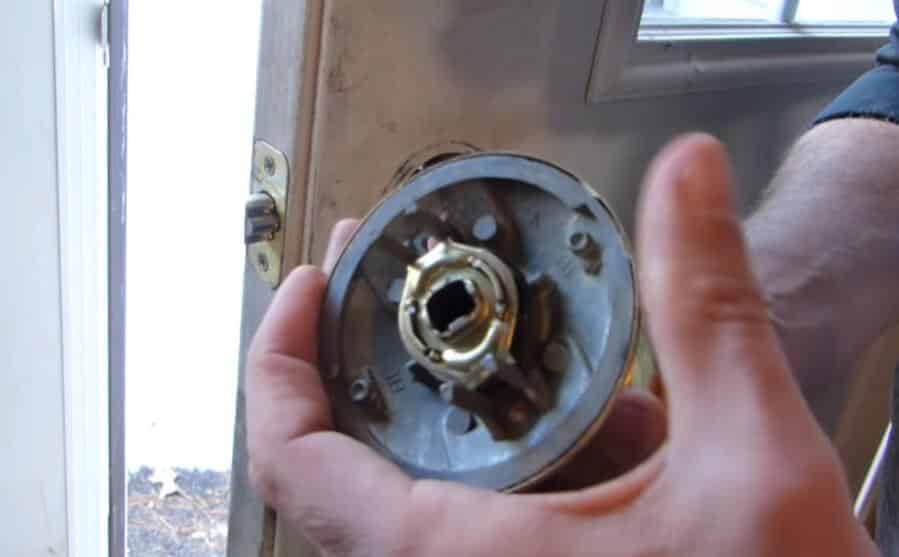
Check the hinges. If the door still sticks, check the hinges to see if they are loose. Tightening the screws on the hinges can help to ensure that the door swings smoothly.
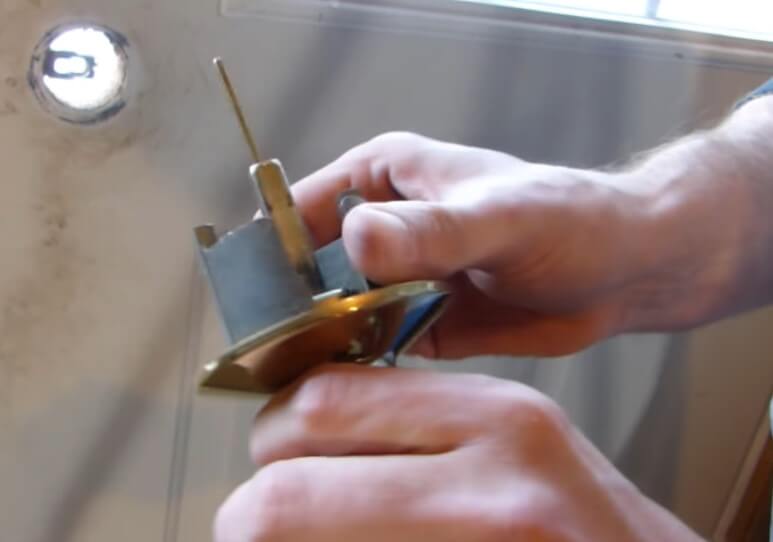
Test the door. Once you have tightened any loose screws or hinges, test the door to ensure that it is opening and closing smoothly.
If the problem persists, move on to the next step.
Method-4: Replacement Process
If none of the previous steps have fixed the issue, you may need to replace the door knob completely. Here’s how:
Identify a replacement. First, you will need to find a suitable replacement for your door knob assembly.
Purchase a new door knob. You have to buy a new door knob from your local hardware store by matches the existing one. Consult the manufacturer’s instructions or a hardware store professional for assistance.
Remove the old assembly. Remove the screws that hold the old assembly in place and remove it from the door.

Install the new assembly. Follow the manufacturer’s instructions to install the new assembly, screwing it in place and testing it to ensure that it works smoothly.
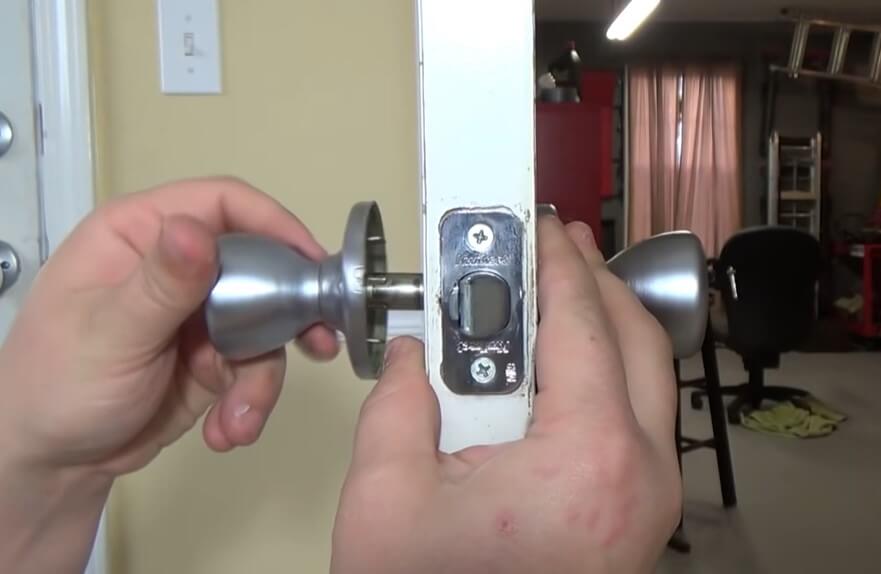
Test the new knob to see if the issue has been fixed.
Fixing a sticking door knob isn’t rocket science, but it can be a little time-consuming. With the steps outlined in this guide, you should be able to fix any sticking door knob issues you encounter.
Preventing Future Sticking Door Knob Issues
Door knobs are an essential part of our daily lives, providing us with security and convenience. However, sometimes these door knobs can become problematic, and one of the most common issues is when they become stuck when turned.
If we know how to prevent sticking the door knob in advance, we can save ourselves from daunting fixes or buying a new one.
Therefore, here we will discuss ways of preventing future sticking door knob issues, exploring regular maintenance tips, ways to detect early signs of the problem, and tips for proper use of the door knob.
Regular Maintenance Tips
Regular maintenance of the door knob can prevent sticking issues from arising. Here are some tips to help you keep your door knobs in good working condition:
- Clean your door knob regularly to prevent dirt and grime buildup. Use a damp cloth and a mild detergent or soap to gently clean the knob.
- Check the screws on the door knob from time to time to make sure they are tightened. Loose screws can cause the knob to become wobbly and may lead to sticking issues over time.
- Lubricate the hinges and latch occasionally with a suitable lubricant. This will help your door knob turn smoothly without sticking.
How To Detect Early Signs Of The Sticking Door Knob
Detecting early signs of sticking door knobs can help you prevent the issue from getting worse. Here are some signs that you should look out for:
- A door knob that takes longer than usual to turn
- A door knob that makes grinding or scraping noises when turned
- A door knob that feels stiff or difficult to turn
If you notice any of these signs, take action as soon as possible to prevent the problem from worsening.
Tips For Proper Use Of The Door Knob
Proper use of the door knob can go a long way in preventing sticking issues. Here are some tips to keep in mind:
- Turn the door knob gently and smoothly. Avoid using excessive force, as this can cause the knob to become misaligned and start sticking.
- Use your key to unlock the door before turning the knob. Avoid turning the knob while it is in the locked position, as this can cause unnecessary wear and tear.
- After unlocking the door, turn the knob fully to open it. Partially opening the door can create strain on the knob and may cause it to become stuck at a later time.
Taking good care of your door knobs can help prevent sticking issues from arising in the future.
By following our tips for regular maintenance, detecting early signs of the problem, and proper use of the door knob, you can ensure that your door knobs function smoothly and efficiently for years to come.
FAQs: How Can I Fix Door Knob Sticking When Turned?
Why Is My Door Knob Sticking?
A door knob can stick due to dirt, rust, or misalignment of the latch.
How Can I Fix A Sticking Door Knob?
Spray lubricant on the latch, tighten loose screws, or adjust the strike plate.
Can A Sticking Door Knob Be Dangerous?
Yes, a sticking door knob can prevent quick exits during an emergency.
When Should I Call A Professional For Help?
If the problem persists after DIY fixes or the lock is damaged, call a locksmith.
Conclusion
Overall, a sticking door knob is a problem that can lead to frustration and inconvenience for anyone attempting to use the door. However, with a few simple steps, this issue can often be resolved without the need for professional assistance.
Whether it’s a result of loose screws, a misaligned strike plate, or excessive paint buildup, identifying the source of the problem is key to ensuring a smooth-functioning knob. By cleaning and lubricating the knob and strike plate, tightening any loose screws, and sanding away any paint buildup, most sticking knobs can be restored to their proper function in no time.
It’s important to address this issue promptly, as neglecting it can lead to additional damage to the door or the knob mechanism itself.
So, the next time you experience a sticking knob, take a little time to diagnose the problem and make the necessary adjustments to ensure a hassle-free entrance and exit from your home or office.
